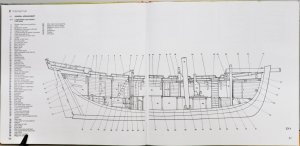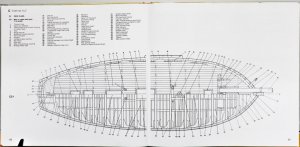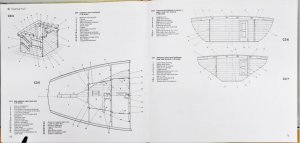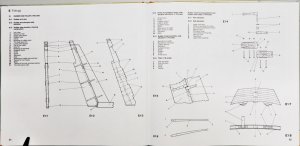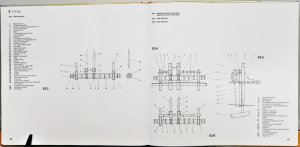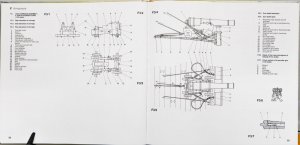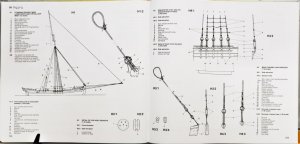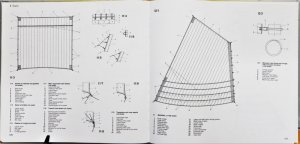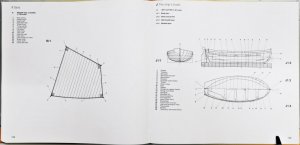Book Review:
The Naval Cutter ALERT 1777 (Anatomy of the Ship)
by Peter Goodwin
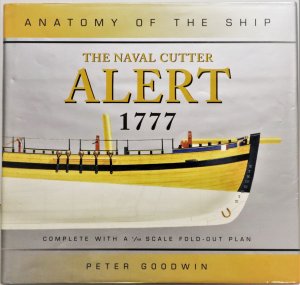
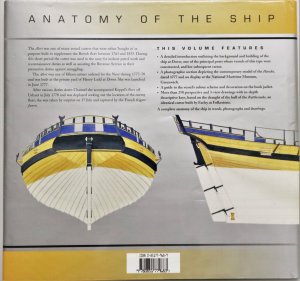

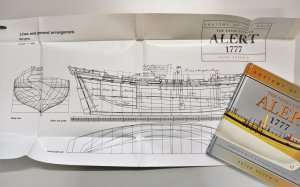
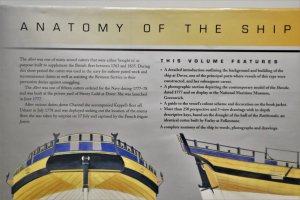
Synopsis:
This volume features a full description of this armed cutter, its concept, origins, design details and wartime service
With over 100 perspective and 3-view drawings, accompanied by in-depth descriptive keys and photos
This revised edition features a large-scale plan of the vessel on the reverse of an extended fold-out jacket
A title in a series that has established a substantial following in its specialist field
The Alert was one of many armed cutters that were used to supplement the British fleet between 1763 and 1835, and these small swift vessels were generally employed in minor roles such as conveying dispatches, routine patrol work and reconnaissance. Alert was constructed in Dover in 1777 an d was captured by the French in July 1778 while acting as escort for Keppel's fleet off Ushant.
The 'Anatomy of the Ship' series aims to provide the finest documentation of individual ships and ship types ever published. What makes the series unique is a complete set of superbly executed line drawings, both the conventional type of plan as well as explanatory views, with fully descriptive keys. These are supported by technical details, photos and a record of the ship's service history.
Peter Goodwin has been interested in wooden shipbuilding since his days as an engineering apprentice. He has written two other 'Anatomy of the Ship' volumes, The 20-Gun Ship Blandford and The Bomb Vessel Granado. His other Conway books include Nelson's Ships, and The Construction and Fitting of the Sailing Man of War 1650-1850. He has been the Keeper and Curator of HMS Victory for over ten years.


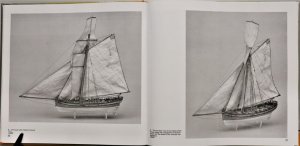
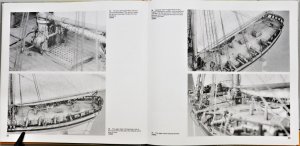
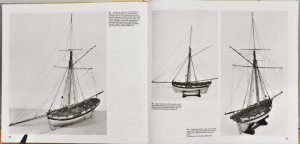
About the Author
Peter Goodwin is widely acknowledged as one of the leading writers on the sailing warship. His published titles include the classic The Construction and Fitting of the Sailing Man of War (Conway, 1990), The Bomb Vessel GRANADO (Anatomy of the Ship), Nelson's Ships (Conway 2002) and The Ships of Trafalgar (2005). Peter was Keeper and Curator of HMS Victory for some 20 years.'
One model shown in the Anatomy book by Goodwin is in the collection of the NMM,
https://collections.rmg.co.uk/colle...el-318037;browseBy=vessel;vesselFacetLetter=H




Scale: 1:96. A contemporary full hull model of the 'Hawke' (active 1777), a revenue cutter, built plank on frame (?) using clinker construction in the Georgian style. The model is decked, fully equipped and rigged with a full suit of original sails set. The name ‘Hawke’ has been painted on the stern as well as on the original display case. It has not been possible, however, to identify a vessel of this name that fits the dimensions of 72 feet along the deck by 25 feet in the beam and tonnage of 180 (builders old measurement). However, the dimensions are approximately correct for a typical naval cutter of the mid-18th century, although it is fitted with more guns than usual. The rigging shows the arrangement and layout of the three square sails and their yards, which is the maximum that could be carried with a cutter rig
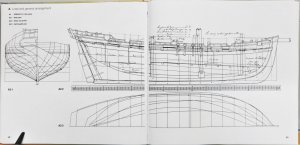
Contents:
Foreword / Introduction and Author´s Note
INTRODUCTION (page 9 to 28)
Development
History
Construction
Steering gear
Ground tackle
Pumps
Armament
Mast and Yards
Rigging
Sails
Ship´s boats
Provisions
Bibliography
THE PHOTOGRAPHS (page 29 to 44)
THE DRAWINGS (page 45 to 126)


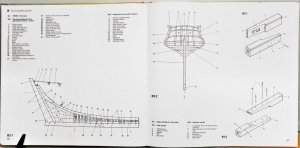
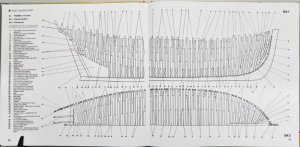
Review:
A very interesting subject about a type of ship, which is often unknown.
The book with the descriptions and especially the detailed draughts is giving a modeler best information to build such a model in scratch or even the kit model which is in moment under preparation by Trident models
As often with this series, this book is highly recommended for the interested modeler
(More Look Inside photos you kind find in the following post)
The Naval Cutter ALERT 1777 (Anatomy of the Ship)
by Peter Goodwin


- Hardcover: 120 pages
- Publisher: Conway Maritime; Revised edition (April 19, 2004)
- Language: English
- ISBN-10: 0851779689
- ISBN-13: 978-0851779683
- Product Dimensions: 10.2 x 1 x 10.2 inches
- Shipping Weight: 1.7 pounds

- Paperback: 128 pages
- Publisher: Chrysalis Books (November 1991)
- Language: English
- ISBN-10: 0851775926
- ISBN-13: 978-0851775920
- Package Dimensions: 10 x 9.5 x 0.6 inches
- Shipping Weight: 1.8 pounds


Synopsis:
This volume features a full description of this armed cutter, its concept, origins, design details and wartime service
With over 100 perspective and 3-view drawings, accompanied by in-depth descriptive keys and photos
This revised edition features a large-scale plan of the vessel on the reverse of an extended fold-out jacket
A title in a series that has established a substantial following in its specialist field
The Alert was one of many armed cutters that were used to supplement the British fleet between 1763 and 1835, and these small swift vessels were generally employed in minor roles such as conveying dispatches, routine patrol work and reconnaissance. Alert was constructed in Dover in 1777 an d was captured by the French in July 1778 while acting as escort for Keppel's fleet off Ushant.
The 'Anatomy of the Ship' series aims to provide the finest documentation of individual ships and ship types ever published. What makes the series unique is a complete set of superbly executed line drawings, both the conventional type of plan as well as explanatory views, with fully descriptive keys. These are supported by technical details, photos and a record of the ship's service history.
Peter Goodwin has been interested in wooden shipbuilding since his days as an engineering apprentice. He has written two other 'Anatomy of the Ship' volumes, The 20-Gun Ship Blandford and The Bomb Vessel Granado. His other Conway books include Nelson's Ships, and The Construction and Fitting of the Sailing Man of War 1650-1850. He has been the Keeper and Curator of HMS Victory for over ten years.





About the Author
Peter Goodwin is widely acknowledged as one of the leading writers on the sailing warship. His published titles include the classic The Construction and Fitting of the Sailing Man of War (Conway, 1990), The Bomb Vessel GRANADO (Anatomy of the Ship), Nelson's Ships (Conway 2002) and The Ships of Trafalgar (2005). Peter was Keeper and Curator of HMS Victory for some 20 years.'
One model shown in the Anatomy book by Goodwin is in the collection of the NMM,
https://collections.rmg.co.uk/colle...el-318037;browseBy=vessel;vesselFacetLetter=H




Scale: 1:96. A contemporary full hull model of the 'Hawke' (active 1777), a revenue cutter, built plank on frame (?) using clinker construction in the Georgian style. The model is decked, fully equipped and rigged with a full suit of original sails set. The name ‘Hawke’ has been painted on the stern as well as on the original display case. It has not been possible, however, to identify a vessel of this name that fits the dimensions of 72 feet along the deck by 25 feet in the beam and tonnage of 180 (builders old measurement). However, the dimensions are approximately correct for a typical naval cutter of the mid-18th century, although it is fitted with more guns than usual. The rigging shows the arrangement and layout of the three square sails and their yards, which is the maximum that could be carried with a cutter rig

Contents:
Foreword / Introduction and Author´s Note
INTRODUCTION (page 9 to 28)
Development
History
Construction
Steering gear
Ground tackle
Pumps
Armament
Mast and Yards
Rigging
Sails
Ship´s boats
Provisions
Bibliography
THE PHOTOGRAPHS (page 29 to 44)
THE DRAWINGS (page 45 to 126)
- Lines and general arrangement
- Hull Construction
- Internal Hull
- External Hull
- Fittings
- Armament
- Mast and Yards
- Rigging
- Sails
- Ship´s Boats




Review:
A very interesting subject about a type of ship, which is often unknown.
The book with the descriptions and especially the detailed draughts is giving a modeler best information to build such a model in scratch or even the kit model which is in moment under preparation by Trident models
As often with this series, this book is highly recommended for the interested modeler
(More Look Inside photos you kind find in the following post)





